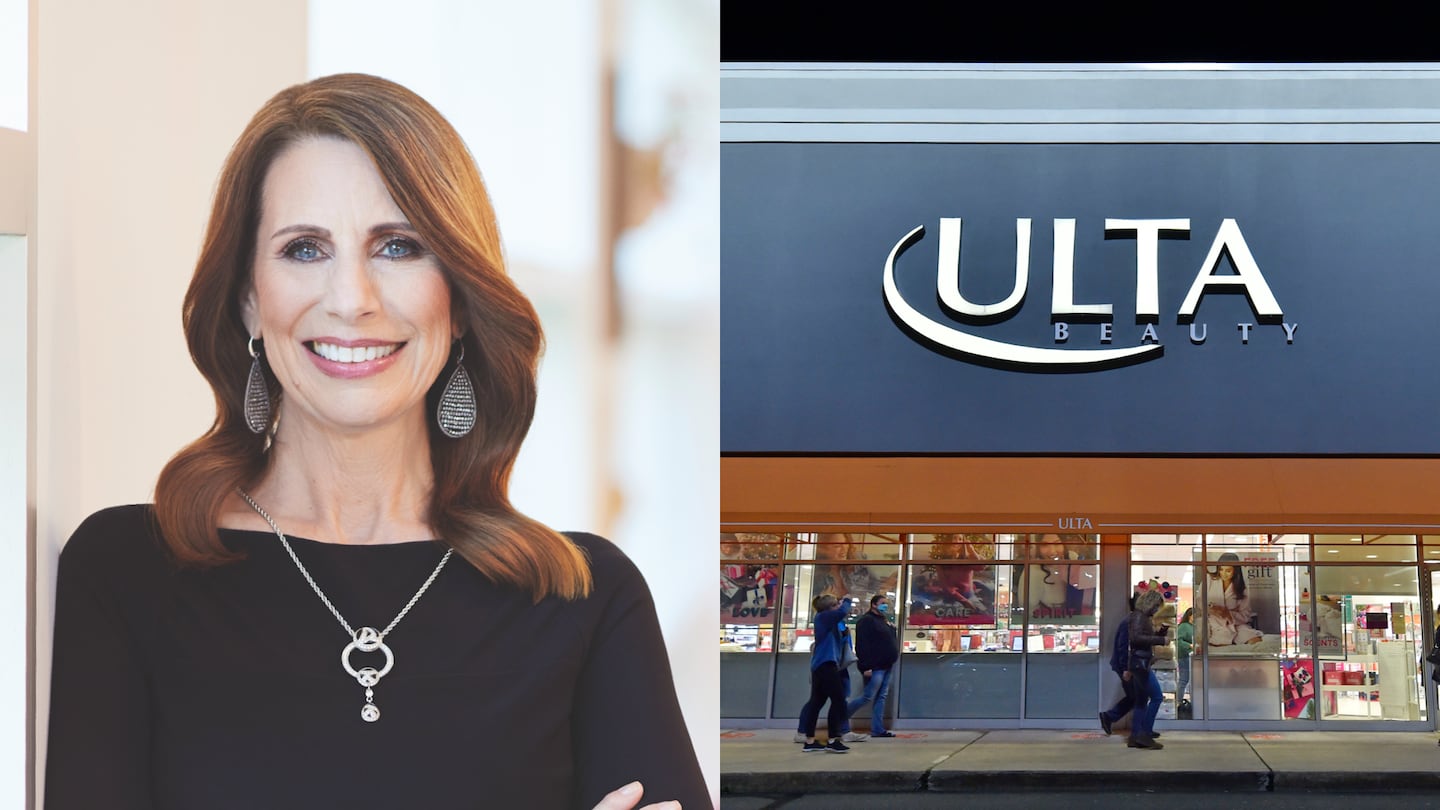
The Business of Fashion
Agenda-setting intelligence, analysis and advice for the global fashion community.

Agenda-setting intelligence, analysis and advice for the global fashion community.

 Opens in new window
Opens in new windowAs the beauty category continues to outpace the global economic outlook, conglomerates, retailers, brands and investors are looking for even more opportunities to evolve. And right now, there is no greater growth vehicle within the segment than wellness. Whether it is the “skinification” of colour cosmetics and hair, or the debut of sexual wellness products in the beauty aisle, companies are willing to stretch the traditional limits of the category and firmly say beauty and wellness are one in the same, according to Monica Arnaudo, chief merchandising officer of Ulta Beauty.
For its part, the US beauty retailer has been on a journey to ensure its offering keeps pace with the changing definition of beauty, underscoring that products and services can and should make people not just look good, but feel good. From first introducing its wellness concept in its bath and body assortment in 2018, to later developing full wellness sections within stores that today include more than 150 brands, consumers would be hard pressed to not find products and services that enable them to take “better care of themselves.”
BoF: Over the last five years, the beauty industry has become enamoured with wellness and themes like ‘beauty from the inside out’ and self-care. Where have you seen the biggest changes in terms of product development, brand positioning and marketing?
Monica Arnaudo: The reality is that beauty, as a stand-alone category, is a feel-good category, and wellness is all about feeling good. There’s always been a bit of a blurring between the two. The catalyst for this really came more to the fore because of what transpired during the pandemic when people really were focused on taking better care of themselves.
ADVERTISEMENT
We saw that really start in skin care. People started adding more products to their routine and spending more time on their routines. It evolved to hair. If you think about the product piece, we really started to see an evolution of more scalp treatments and more masking as it relates to hair. Then, of course, it eased into more of a do-it-yourself routine.
And here we are today. The amazing thing for the beauty industry in total is that people haven’t changed their routines. The consumer, and especially the beauty enthusiast, is still spending that amount maintaining their routines in skin and hair; and now they’re spending more time in makeup again because they’re not home, they’re out — they’re back in the workplace, they’re going to weddings, they’re going to events, they’re travelling, they’re taking vacations.
While that was going on, there were other things being discussed — for example, the importance of taking care of our mental health. There is definitely an association with beauty and how it can help with that because beauty does really help people feel better.
When you think about the marketing and the language, we saw an influx of communication about taking better care of yourself and spending time in that way, which completely ties into wellness — 65 percent of consumers connect beauty and wellness and, actually, for the beauty enthusiast, that’s 72 percent.
BoF: Where has Ulta Beauty been in the category historically and what is your strategy going forward?
MA: Historically, we played in the category that I would describe as everyday care, in things like deodorants and oral care and bath and body products. Then we launched the wellness shop in 2021. … We wanted to create something that crossed categories, was very easy for our guests to shop. We offered products that were very accessible, and a range of products. We really wanted to focus on the areas that we knew our guests had interest in.
We went about five years ago from more of the everyday basic care to laying out these five pillars, which everyday care is a part of. We added supplements and ingestibles, so that was pillar number two; relax and renew, this is where during the pandemic we really saw people leaning more into this space; and spa at home, again, people taking time during the pandemic. Then we launched intimate wellness at the end of Q3 of 2022, online only, and this was definitely a space that, again, we knew that our guests, especially the younger consumer, wanted to have a place to shop where they could learn about the products. It was a comfortable place for them to explore.
We started with about 400 stores and now we’re in 800 stores and we’ve got the wellness shop online.
ADVERTISEMENT
BoF: When you think about brand partners, what do you look for?
MA: It always starts with the guest and where we might have opportunity. Then, when we are looking at a specific brand, and this is the piece that crosses categories: are they fulfilling a need, is there a founder involved, what is the authenticity? I think of Love Wellness and the need that was there for easy-to-relate-to supplements and ingestibles that were solution-orientated, focused on things like bloating, for example.
We also look for a founder who’s highly engaged and wants to build the business with us. … We’ve been on a journey of listening to our consumer and meeting various brands in this space. Our emerging brand team reviews so many new brands every year, hundreds upon hundreds, so we’ve seen a lot more in wellness.
BoF: What about the blurring of the categories? We are already seeing things like oral wellness now and products that you may have found in the drugstore aisle being elevated and positioned as wellness, like supplements.
MA: It will continue to blur because, to your point, we’re seeing it across multiple categories. … People are moving beyond defining beauty through societal standards towards individual qualities like confidence and self-acceptance that radiate an aura of beauty, and beauty products play a role in every step of our mental health journey.
We define wellness as for the mind, body and spirit.
There used to be a negative connotation of mental health. Now it’s so much more acceptable. It’s okay to talk about maybe having anxiety, and things like this.
BoF: How important is it to bring that global perspective of wellness, like traditional Chinese medicine or ayurveda or the origins of K-Beauty, to stores and beauty retail?
ADVERTISEMENT
MA: It’s extremely important because in order to fulfil our guests’ desires, we have to take a holistic view. Our studies show that 41 percent of people globally believe that wellness is more of a communal and societal issue than an individual goal. So again for us, it’s our responsibility to look at it in a holistic, global way and, to your point, maybe look at some of these remedies that come out of Asia, in general, that’s an important piece of it. We need to have a global perspective.
BoF: Ulta Beauty recently expanded its luxury assortment. How do you see luxury intertwining in wellness today and in the next three to five years?
MA: Luxury is a segment of the business that has continued to grow. Even when you think about what transpired during the pandemic and when maybe people were pulling back a little bit on their spend, they were not pulling back in luxury beauty; that was actually an area where they were leaning into more. The other aspect that has propelled luxury beauty is the influx of social media, especially TikTok. We know that 80-plus percent of Gen-Z and Millennials will buy a luxury beauty product if they see it on TikTok, on social media.
A little over a year ago we launched Chanel No1, which was not only tied to Chanel, but luxury fashion. The other cool thing about that brand is that it was taking a clean, conscious approach. …
Wellness will probably be interconnected with luxury and perhaps we will see either existing luxury brands delve more into wellness-type products or wellness brands take more of a luxury approach.
We will see luxury brands delve more into wellness or wellness brands take more of a luxury approach.
BoF: To target that type of consumer, there’s so much more room to go into spas, or whatever La Prairie does in its clinics. It just seems like the sky is the limit there.
MA: That’s such a good point because what else do you think of when you go to a spa? You think, ‘I’m going to a spa to take good care of myself, to feel better,’ and that’s what wellness is all about, and you want to have luxurious products when you do that.
BoF: Do you think wellness will become — or maybe it already is — a top revenue driver for yourself and for other players in beauty?
MA: Because we’re optimistic about the growth potential and the growth that we’re seeing currently in the brands in the assortment that we have, I think it will continue to be a growth driver for us. We have more than 150 brands that touch wellness [and] have about 600 brands in our assortment in total.
BoF: Do you think we’re going to get to a place where the terms ‘beauty’ and ‘wellness’ are interchangeable?
MA: Yes, absolutely. Based on all our insights, I think we’re there. You did hit on something that we also learned in our insights, and it is such a big part of beauty and wellness; it’s about how you feel about yourself – it’s not always the external – I look in the mirror and because of this … It’s that I feel this way. Beauty is there to enhance, it’s there to help you feel even better, but so much of it is internal.
This interview has been edited and condensed.
This article first appeared in The State of Fashion: Beauty report, co-published by BoF and McKinsey & Company.
 Opens in new window
Opens in new windowBeauty megadeals may be few and far between over the near term, but M&A will still be critical for buyers and sellers seeking growth, innovation and competitive product portfolios, reports The State of Fashion: Beauty.

Priya Rao is Executive Editor at The Business of Beauty at BoF. She is based in New York and oversees BoF’s beauty and wellness coverage.
The founder, who was ousted and recently came back to the line as CEO, will regain control of the company.
Beauty labels hope to court the concert set for both brand awareness and trendsetting opportunities.
Black founders carry a markedly higher burden when it comes to educating investors on the value and viability of their business ideas — but there is an art and science behind knowing when your brand is ready and what kind of investors will be the best fit.
Landing a retail partnership is often seen as a major milestone for beauty founders — but it brings a bevy of new challenges, from the logistical complexities to setting a marketing budget. Black entrepreneurs, who typically have far less capital to work with, often face tough choices.